Topics
Category
Era
St. Peter State Hospital
In the 1860s, Minnesota experienced rapid population growth due to immigration. To serve the needs of these new citizens, the state legislature passed an act for the establishment of an asylum for the “insane” in St. Peter in 1866. As it filled to capacity and then expanded, it became the primary site for housing mentally ill people considered dangerous or sexually aggressive.
Before the 1860s, the territorial legislature had only outlined procedures related to mental illness. First, it promised to provide guardianship for those insane persons whose families could pay a guardianship fee. Second, it decided to confine insane persons who were considered a threat to public order or safety in poor farms, county jails, or poorhouses. Other families and individuals were left to fend for themselves if they needed assistance. This led to the historically common practice of families locking their insane relative in a basement or spare room.
By the early 1860s, Minnesota’s jails and poorhouses were already overcrowded. The state began seeking means to segregate unemployed poor people for efficiency’s sake, with the hope of one day rehabilitating a portion of them back into the workforce. In 1862, Governor Alexander Ramsey agreed to pay the superintendent of Mount Pleasant asylum in Iowa a fee to incarcerate the state’s unhoused insane population. Their arrangement came to an end in 1866 when the superintendent officially requested the return of all patents due to overcrowding. This forced the legislature to pass a bill authorizing the establishment of a hospital for the insane in Minnesota that same year.
Town leaders across Minnesota responded to the search committee’s call for a suitable site for the hospital. The initial donation to the state, they realized, would attract major state investment in the long term. A 210-acre farm in St. Peter purchased by citizens for $7000 won out due to its open land; attractive landscapes that would soothe troubled minds; the natural protection provided by nearby bluffs; and access to abundant water and wood.
Patients returned from Iowa in December 1866 to live in a temporary structure on the St. Peter site until permanent buildings could be built. Construction was a slow and arduous process lasting decades, but patients were gradually transferred to new buildings as they were completed. In November 1880, a fire raged through the North Wing, destroying the building, killing at least twenty-five patients, and resulting in the disappearance of six more. Despite this major setback, construction continued, and all patients were moved into new buildings by January of 1885.
St. Peter grew rapidly to keep pace with the demand from families and the state. In 1892, the grounds expanded to encompass over 800 acres. Administrators exploited the hospital's growing population through the institutional peonage system, which used free patient labor in the name of "occupational therapy." Patient workers made the hospital effectively self-sufficient, capable of feeding the patients and maintaining its buildings. Further institutional costs were cut thanks to extensive patient labor in cutting firewood, carpentry, and cutting ice from the Minnesota River. A few patients found paid work in the local community.
Despite cycles of construction, crises of overcrowding burdened the hospital as early as the 1870s. As it built new buildings, the state took the opportunity to segregate different patient groups. Ideally, this would have allowed for increasing treatment specialization according to diagnosis (e.g. alcoholism, “feeble-mindedness,” tuberculosis) and prognosis (chronic or acute). As overcrowding began to progressively affect all Minnesotan institutions throughout the twentieth century, specialized attention and treatments were seldom possible.
St. Peter began segregating patients in May 1911, after the construction of the Asylum for the Dangerously Insane. As the name suggests, it was built to house the patients considered too dangerous to stay with the normal population. To that end, the cells were barred, recreation was shorter and more limited, patients were more often confined in straight jackets, and punishments were both more frequent and more severe.
Reforms in the 1950s improved the food, added recreational options, and eliminated restraints as a punishment. In 1957, the institution’s name was changed to Minnesota Security Hospital in response to patient protest around the stigmatizing nature of the original name. In 1970, the Security Hospital expanded to include the Intensive Treatment Program for Sexual Aggressives.
Although both the Security Hospital and the main hospital (renamed St. Peter Regional Treatment Center by Governor Rudy Perpich in 1985) shrank in response to national and local court cases and changes in policy in the 1980s and 90s, they remain open in 2023.
Bibliography
Erickson, William D. The Great Charity: Minnesota's First Mental Hospital at St. Peter, Minnesota, 1866–1991. St. Peter, MN: N.p., 1991.
First Annual Report of the Board of Trustees and Officers of the Minnesota Hospital for Insane, to the Governor of the State of Minnesota, for the Year 1867. St. Paul: Press Printing Company, 1868.
https://mn.gov/mnddc/past/pdf/60s/67/67-FAR-CKB.pdf
Minnesota Department of Human Services. The Evolution of State Operated Services, 2007.
https://mn.gov/mnddc/past/pdf/00s/07/07-DHS-ENG.pdf
Resman, Michael. Asylums, Treatment Centers and Genetic Jails: A History of Minnesota’s State Hospitals. St. Cloud: North Star Press of St. Cloud, 2013.
St. Peter Regional Treatment Center. Minnesota Statutes, Laws, Chapter 6 (1866).
https://www.lrl.mn.gov/agencies/detail?AgencyID=1417
“State of Mind | A History of Minnesota's First State Hospital.” YouTube, Minnesota DHS, August 17, 2018.
https://www.youtube.com/watch?v=PEum-YZScIE
Related Resources
Primary
I.484 digital
St. Peter State Hospital patient recollections
Audio-visual Collection, Minnesota Historical Society, St. Paul
Description: Recollections of a former patient at St. Peter State Hospital hospitalized January through March of 1952. Subjects discussed include the patient's mental health struggles in the early 1950s; triggering events; what led to being taken to St. Peter State Hospital; and recollections of the hospital, staff, and other patients. The recordings were made by the former patient—one part on November 21, 2016, and two parts recorded on December 5, 2016, to retell his story after viewing his hospital file at the Minnesota Historical Society.
https://search.mnhs.org/index.php?q=%22Collection+I.484%22&brand=cms
Larson, Martin. Guess What Happened Today: My 30 Years with the Minnesota State Hospital System. Kearney, NE: Morris Publishing, 2010.
OH124
Minnesota Psychiatry in the Mid-to-Late Twentieth Century Oral History Project
Oral History Collection, Minnesota Historical Society, St. Paul
Description: Collection of interviews of psychiatrists throughout Minnesota done in the 1970s by Dr. Marvin Sukov, and by David Cline and Deane Manolis in 2011. The interviews begin with recollections of the 1940s and 1950s and trace the progress of medicines, the perception of mental illness, and practice of psychiatrists in rural and urban Minnesota. Interviewed by Marvin Sukov, David Cline, Deane Manolis, and Donald Daggett.
http://www2.mnhs.org/library/findaids/oh124.xml
Russell, Alice Bingham. A Plea for the Insane. By Friends of the Living Dead...Arranged by Alice Bingham Russell. Minneapolis: Roberts Publishing, 1898.
https://mnpals-mhs.primo.exlibrisgroup.com/discovery/fulldisplay?docid=alma990016615820104294
Secondary
Erickson, William D. “Establishing Minnesota's First Hospital for the Insane.” Minnesota History 53, no. 2 (Summer 1992): 42–55.
http://collections.mnhs.org/mnhistorymagazine/articles/53/v53i02p042-055.pdf
Freeman, George H. Historical Development of the Minnesota Hospitals for the Care of the Insane. Minneapolis: Minnesota Mental Hygiene Society, 1941.
Jordan, Philip D. The People's Health: A History of Public Health in Minnesota to 1948. St. Paul: Minnesota Historical Society, 1953.
Kilbourne, Arthur. "Minnesota in the Development of the Care of the Insane." American Journal of Psychiatry 85, no. 6 (1929): 1077–1083.
“Mental Health Perspectives: The Forward Look with a Backward Glance” (“Minnesota’s Mental Health Program in Perspective.”) Minnesota Department of Public Welfare, 1965.
https://mn.gov/mnddc/past/pdf/60s/65/65-DPW-MHP.pdf
Murphy, Patricia A. The Public Buildings of the State of Minnesota: An Architectural Heritage. St. Paul: Minnesota Historical Society, 1986.
Web
“Minnesota's First Kirkbride Asylum in St. Peter.” Twin Cities PBS, August 13, 2018.
https://www.tptoriginals.org/minnesotas-first-kirkbride-asylum-in-st-peter
Sandeen, Bob. “Bob Looks Back: 1880 Fire at the St. Peter State Hospital.” Nicollet County Historical Society, October 9, 2020.
https://www.nchsmn.org/bob-looks-back-1880-fire-at-the-st-peter-state-hospital
Related Video
Uprising at St. Peter State Hospital, 1969
Twin News reporter Richard Albers visits St. Peter State Hospital after a patient uprising. The clip includes an interview with Dr. Carl Schwarz, the hospital's medical director. Filmed on September 9, 1969.
More Information
Articles
Related Images
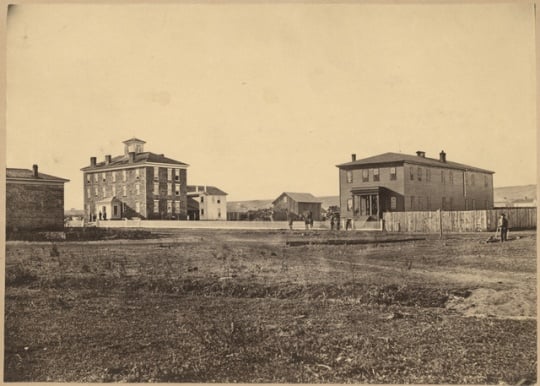
Minnesota State Hospital for the Insane, 1867
Holding Location
Articles
More Information
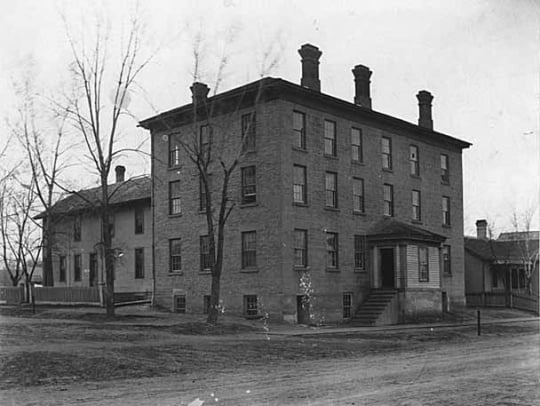
Minnesota State Hospital for the Insane, ca. 1868
Holding Location
Articles
More Information
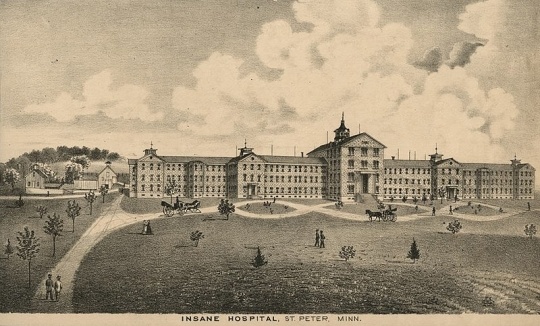
Minnesota State Hospital for the Insane, 1874
Holding Location
Articles
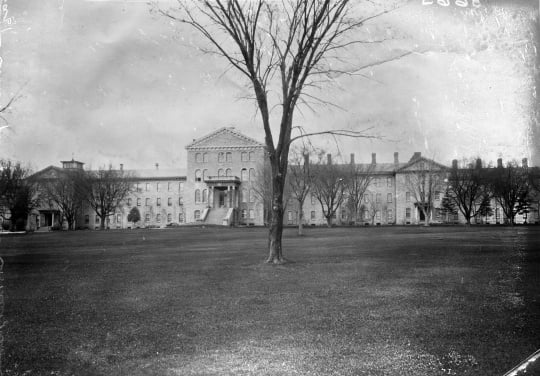
St. Peter State Hospital, ca. 1905
Holding Location
Articles
More Information
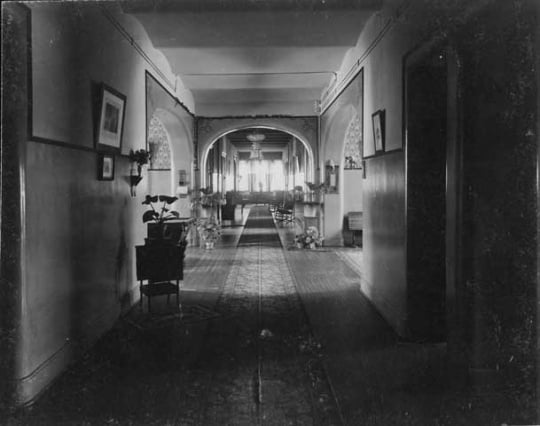
Corridor inside St. Peter State Hospital, ca. 1910
Holding Location
Articles
More Information
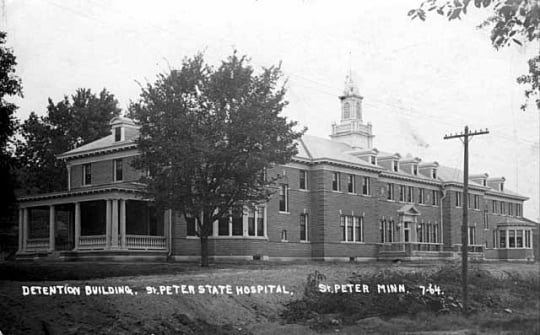
Detention Building at St. Peter State Hospital
Holding Location
Articles
More Information
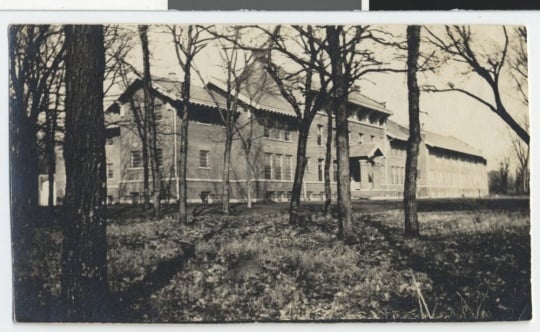
Asylum for the Dangerously Insane at St. Peter State Hospital
Holding Location
Articles
More Information

St. Peter State Hospital, ca. 1920
Holding Location
Articles
More Information
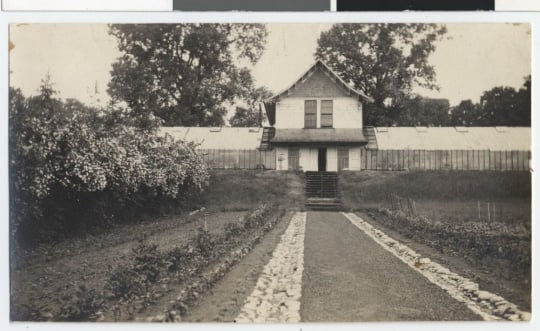
Greenhouse at St. Peter Hospital
Holding Location
Articles
More Information
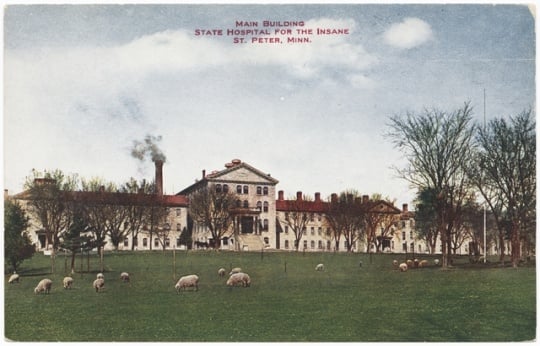
Sheep grazing on the grounds of St. Peter State Hospital
Holding Location
Articles
More Information
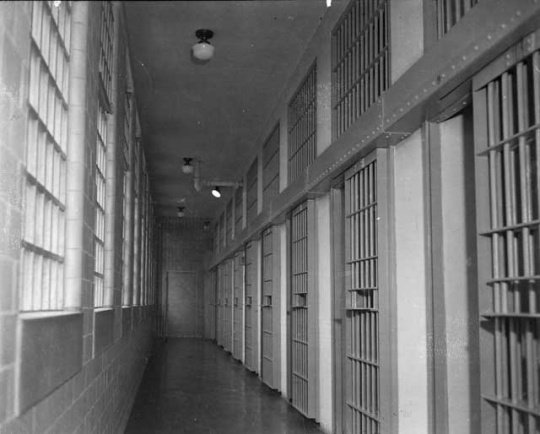
Corridor inside St. Peter State Hospital, ca. 1938
Holding Location
Articles
More Information
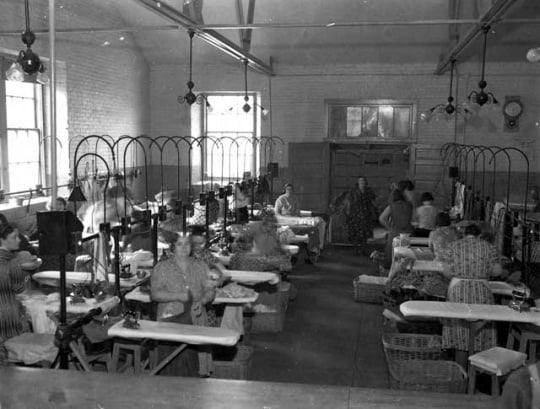
Ironing room inside St. Peter State Hospital
Holding Location
Articles
More Information
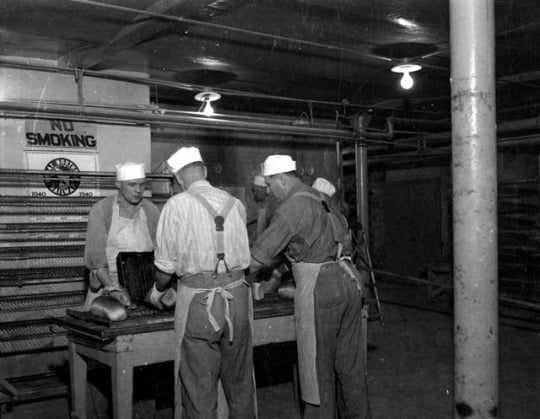
Bakery inside St. Peter State Hospital
Holding Location
Articles
More Information
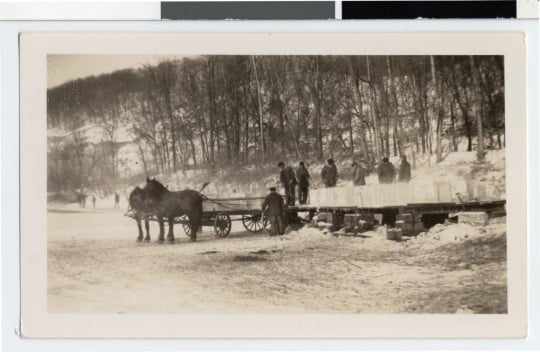
St. Peter State Hospital employees cutting ice
Holding Location
Articles
More Information
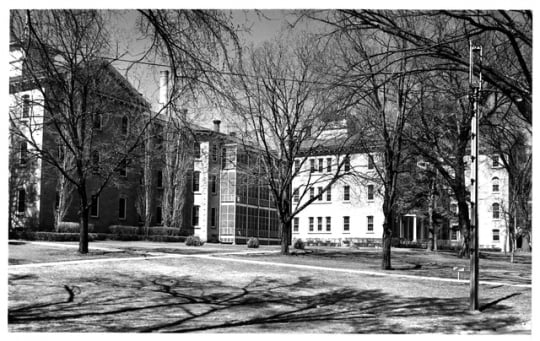
St. Peter State Hospital, ca. 1950
Holding Location
Articles
More Information
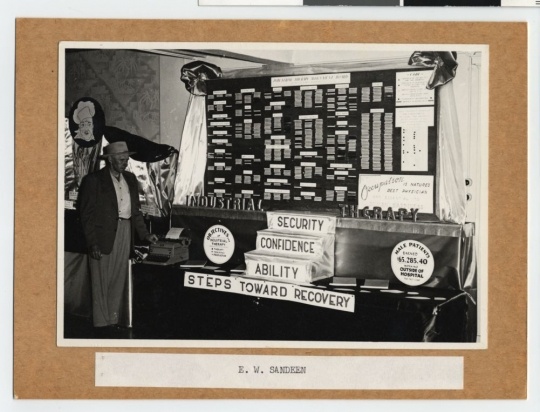
St. Peter State Hospital industrial therapy display
Holding Location
Articles
More Information
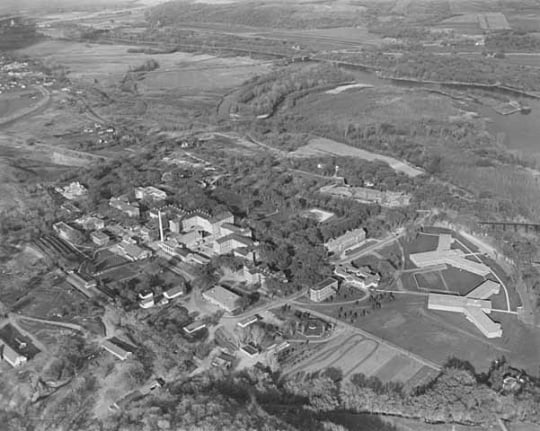
Aerial view of St Peter State Hospital
Aerial view of St Peter State Hospital (St. Peter, Minnesota), April 13, 1954. Photo by the Minneapolis Star Journal–Tribune.
Holding Location
Articles
More Information
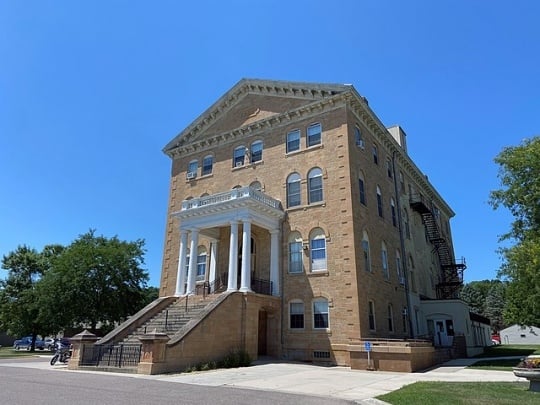
St. Peter State Hospital Museum
Holding Location
Articles
Related Articles
Turning Point
Waves of immigrants arrive in Minnesota in the 1860s. Men and women alike join the labor force, leaving mentally ill relatives without at-home caretakers during the work day. As a result, both families and the state recognize the need for public asylums, and the Minnesota legislature authorizes construction of a hospital for the insane in St. Peter in 1866.
Chronology
1866
1867
1876
1880
1892
1893
1901
1907
1911
1939
1953
1957
1963
1970
1980s
1985
2011
2017
Bibliography
Erickson, William D. The Great Charity: Minnesota's First Mental Hospital at St. Peter, Minnesota, 1866–1991. St. Peter, MN: N.p., 1991.
First Annual Report of the Board of Trustees and Officers of the Minnesota Hospital for Insane, to the Governor of the State of Minnesota, for the Year 1867. St. Paul: Press Printing Company, 1868.
https://mn.gov/mnddc/past/pdf/60s/67/67-FAR-CKB.pdf
Minnesota Department of Human Services. The Evolution of State Operated Services, 2007.
https://mn.gov/mnddc/past/pdf/00s/07/07-DHS-ENG.pdf
Resman, Michael. Asylums, Treatment Centers and Genetic Jails: A History of Minnesota’s State Hospitals. St. Cloud: North Star Press of St. Cloud, 2013.
St. Peter Regional Treatment Center. Minnesota Statutes, Laws, Chapter 6 (1866).
https://www.lrl.mn.gov/agencies/detail?AgencyID=1417
“State of Mind | A History of Minnesota's First State Hospital.” YouTube, Minnesota DHS, August 17, 2018.
https://www.youtube.com/watch?v=PEum-YZScIE
Related Resources
Primary
I.484 digital
St. Peter State Hospital patient recollections
Audio-visual Collection, Minnesota Historical Society, St. Paul
Description: Recollections of a former patient at St. Peter State Hospital hospitalized January through March of 1952. Subjects discussed include the patient's mental health struggles in the early 1950s; triggering events; what led to being taken to St. Peter State Hospital; and recollections of the hospital, staff, and other patients. The recordings were made by the former patient—one part on November 21, 2016, and two parts recorded on December 5, 2016, to retell his story after viewing his hospital file at the Minnesota Historical Society.
https://search.mnhs.org/index.php?q=%22Collection+I.484%22&brand=cms
Larson, Martin. Guess What Happened Today: My 30 Years with the Minnesota State Hospital System. Kearney, NE: Morris Publishing, 2010.
OH124
Minnesota Psychiatry in the Mid-to-Late Twentieth Century Oral History Project
Oral History Collection, Minnesota Historical Society, St. Paul
Description: Collection of interviews of psychiatrists throughout Minnesota done in the 1970s by Dr. Marvin Sukov, and by David Cline and Deane Manolis in 2011. The interviews begin with recollections of the 1940s and 1950s and trace the progress of medicines, the perception of mental illness, and practice of psychiatrists in rural and urban Minnesota. Interviewed by Marvin Sukov, David Cline, Deane Manolis, and Donald Daggett.
http://www2.mnhs.org/library/findaids/oh124.xml
Russell, Alice Bingham. A Plea for the Insane. By Friends of the Living Dead...Arranged by Alice Bingham Russell. Minneapolis: Roberts Publishing, 1898.
https://mnpals-mhs.primo.exlibrisgroup.com/discovery/fulldisplay?docid=alma990016615820104294
Secondary
Erickson, William D. “Establishing Minnesota's First Hospital for the Insane.” Minnesota History 53, no. 2 (Summer 1992): 42–55.
http://collections.mnhs.org/mnhistorymagazine/articles/53/v53i02p042-055.pdf
Freeman, George H. Historical Development of the Minnesota Hospitals for the Care of the Insane. Minneapolis: Minnesota Mental Hygiene Society, 1941.
Jordan, Philip D. The People's Health: A History of Public Health in Minnesota to 1948. St. Paul: Minnesota Historical Society, 1953.
Kilbourne, Arthur. "Minnesota in the Development of the Care of the Insane." American Journal of Psychiatry 85, no. 6 (1929): 1077–1083.
“Mental Health Perspectives: The Forward Look with a Backward Glance” (“Minnesota’s Mental Health Program in Perspective.”) Minnesota Department of Public Welfare, 1965.
https://mn.gov/mnddc/past/pdf/60s/65/65-DPW-MHP.pdf
Murphy, Patricia A. The Public Buildings of the State of Minnesota: An Architectural Heritage. St. Paul: Minnesota Historical Society, 1986.
Web
“Minnesota's First Kirkbride Asylum in St. Peter.” Twin Cities PBS, August 13, 2018.
https://www.tptoriginals.org/minnesotas-first-kirkbride-asylum-in-st-peter
Sandeen, Bob. “Bob Looks Back: 1880 Fire at the St. Peter State Hospital.” Nicollet County Historical Society, October 9, 2020.
https://www.nchsmn.org/bob-looks-back-1880-fire-at-the-st-peter-state-hospital




















